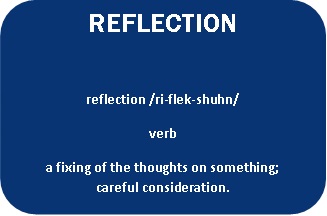 A Coaching Power Tool Created by Matthew Francis
A Coaching Power Tool Created by Matthew Francis
(High-Performance Coach – Business Executives and Athletes, SOUTH AFRICA)
 Introduction
Introduction
When you look into a mirror you see your reflection. But that reflection is also a picture of yourself back in time. In fact, when you are standing exactly 1 meter from your mirror, you are seeing 6,671282 nanoseconds back in time!
This is your reflection. A brief changing snapshot in time.

The purpose of a mirror’s reflection is to check your appearance before leaving home or notice danger nearby.
We also collect other snapshots in time. Photos. We frame them on our walls or post them on our social media pages. Photos are unchanging and no matter how hard we try we are rarely able to change the way we look in photos.
The way we think of ourselves, our memories, our past performances, or our experiences can be approached either as an image in the mirror or the photo on the wall. Is there a difference? Or, are they all just memories?
Studies show the way we approach our memories has a powerful effect on our present and our future state of mind, stress level, and anxiety level. (Nolen-Hoeksema, Tartakovsky, Luerssen, Schreiner, and others)
There are two contrasting options available, or roads we can travel down as we approach our memories. One is to reflect and the other is to obsess.
Reflection

As we journey through the wonder that is this life, we enjoy both mountaintop and valley experiences. The mountaintop experiences may include; falling in love and getting married, graduating from University, achieving that first promotion, or even becoming a parent, to name but a few. Valley experiences are often painful and leave deep scars in our souls. Valleys can be a conflict with a friend, a divorce, a loss of that all-important championship sports match, or a failure to graduate.
Anna Luerssenexplains, “reflection on the experience is essential” as it helps us to grow and or move on by gaining new insight and understanding of the experience. (2011)
When one reflects, one sees one’s self as the ever-changing, nanosecond version of one’s self. Those who master the art of reflection can see themselves simply as pencil sketches that can be erased and redrawn at any time. They adapt and move. Reflection pulls you forward into the future.
Yale University psychologist, Nolen-Hoeksema illustrates this future pulling effect, showing how people practicing reflection focus on the concrete parts of a situation and the improvements they can make. For example, “A person may wonder, ‘‘I always seem to be rehashing in my mind why I do things,’’ whereas their reflection measure includes items like ‘‘I love analyzing why I do things’’.(Nolen-Hoeksema, Wisco&Lyubomirsky 2008:414)
Reflectionincreasesself-awareness and embraces a growth mindset. Growth mindset individuals recognize their mistakes and hold on to the painful experiences of life very loosely. They understand that they are not defined by the mistake or the experience, rather they are determined to be defined by their response to the experience and their ability to get up and become the best version of themselves. Nelson Mandela’s well-known quote typifies this mindset, “Do not judge me by my successes, judge me by how many times I fell and got back up again”.
In their research into Emotional Intelligence, Bradbury and Greaves describe self-awareness as an essential building block of Emotional Intelligence. (2009:24) The development of Emotional Intelligence is so important that it accounts for 58% of our performance in every sphere of life. (Bradbury & Greaves 2009:20) One can clearly see the connection between the development of self-awareness and increased performance.
Reflection grows self-awareness – Development of self-awareness leads to increased emotional intelligence – Increased Emotional Intelligence leads to an increase in performance.
Makena Shultz outlines the skills necessary for healthy reflection. These skills are, amongst others:
- Self-observation of emotions, attitudes, or behaviors, the controllable, and the uncontrollable.
- Ownership of these emotions, attitudes, or behaviors, the controllable, and the uncontrollable.
- Questioning the motives or reasons behind the above.
- Identifying themes or patterns.
- Learning lessons or take-away’s to become the best version of ourselves. (Schultz 2014)
Reflection is a valuable process that can help us grow personally and professionally every day. Makena Shultz (Schultz 2014)
Approaching our experiences by practicing reflection means we view ourselves as changing reflections in the mirror. What we see is for the express purpose of becoming a better version of ourselves, avoiding danger, or becoming aware of personal blindspots.
If the image (memory, or experience) we see is not moving or changeable, we may be looking at the photo and beginning to move in the direction of obsession.
Obsession
 Reflection becomes an obsession when simply put, it repetitively goes over a thought or a problem without completion. (Wehrenberg2016)Anna Luerssen further states, “what once was healthy reflection turns into obsession – a toxic preoccupation with the experience that fosters negative emotion.” (2011)
Reflection becomes an obsession when simply put, it repetitively goes over a thought or a problem without completion. (Wehrenberg2016)Anna Luerssen further states, “what once was healthy reflection turns into obsession – a toxic preoccupation with the experience that fosters negative emotion.” (2011)
Obsession gets stuck looking not at one’s reflection but rather at a photo of oneself. The reflection is ever-changing, the photo cannot. Where reflection is pulled one into the future, obsession keeps one stuck in the past.
The effects of obsession
-
Increased depression, anxiety, and levels of stress.
In a 2013 study conducted by the BBC’s Lab UK and the University of Liverpool, this kind of obsession was revealed to be the biggest predictor of the most common mental health problems in the UK –depression, anxiety, and levels of stress. (Winterman 2013)
-
Increased negativity & hopelessness.
The quicksands of obsession not only trap us in the toxic preoccupation with past events, but as Nolen-Hoeksema’s research found, “they remember more negative things that happened to them in the past, they interpret situations in their current lives more negatively, and they are more hopeless about the future.”(Margarita Tartakovsky 2011)
It seems that obsession acts like a magnet to negativity in the brain. According to Nolen-Hoeksema, obsession attracts negative memories or experiences to the memory or experience being obsessed about. Also, obsession amplifies the negativity felt about these memories or experiences. These negative emotions then attract further negatives emotions with greater intensity, and the cycle continues.
-
Reduced problem-solving skills.
As the obsession spiral grows, so too does the associated feeling of helplessness. The constant preoccupation with the past prevents one from seeing any solution or any possibility of a solution or way forward. (Margarita Tartakovsky 2011) This is the very essence of a fixed mindset.
-
A Fixed Mindset.
Obsession convinces one that one can never be anything other than the image-obsessed. Obsession leads to fixed mindset generalizations such as, “Because she dumped me, I will never have another girlfriend again.” Or “Why do these things always happen to me? I am such a failure!”
-
Alienated relationships.
In her research, Nolen-Hoeksema found that the frustration felt by friends and family members towards the person stuck in the negative obsessive spiral, can lead to them pulling away from their support. (Margarita Tartakovsky 2011)
-
Missed opportunities.
Obsession is like focussing on the bug on the windshield instead of seeing the view on the horizon. As long as the obsessing lasts, one can never see the opportunities or possibilities life may be presenting. One can never do both.
Letting go of the obsession
How does one begin to let go? Below are some starting block suggestions to help individuals who are stuck in the spiral of obsession to begin letting go:
-
Disrupt the negation spiral.
Put a stop to the magnet to negativity. Instead of obsessing on times where things did not work out, activate positive thoughts where things did work out. (Wehrenberg2016) One may need to enlist the help of friends or a coach to help one effectively unpack or brainstorm positive memories.
-
Deal with one problem at a time.
“Unhook problems from each other”, says MargaretWehrenberg. This helps to discover whether there is a problem to solve or simply a “worry to eliminate.” (2016)
The Four Questions from the work of Byron Katie are extremely helpful at this point.
Example: “I was betrayed by my spouse. They have shown me such disrespect, how can I be expected to forgive them?”
Repeat your statement and ask:
- Is it true? (Yes or no? If no, move to 3.)
- Can you absolutely know that it’s true? (Yes or no.)
- How do you react, what happens, when you believe that thought?
- Who or what would you be without the thought?
(www.thework.com)
-
Get out into nature.
A study by Bratman, Hamilton, Hahn, Daily, and Gross revealed that “participants who went on a 90-min walk through a natural environment reported lower levels of …obsession… (italics added) and showed reduced neural activity in an area of the brain linked to risk for mental illness compared with those who walked through an urban environment. (2015)

-
Exercise.
Villineswrites, “even a single session of exercise could reduce symptoms of …obsession… (italics added)among inpatients with a mental health diagnosis.” (2019)
Application
On the rolling road of life, up’s and down’s are inevitable. We cannot control that. We can, however, learn to respond constructively to the rolling road of life. Reflection responds to life seeing one’s self as an image in a mirror – moving, changing, there to help one become the best version of one’s self.
Obsession on the other hand fixates on life’s experience, as photos – unchanging and negative.
What is important to realize, is that one largely gets to choose how one will respond. One can opt for reflection or obsession.
References
Bradbury T. and Greaves J. 2009 Emotional Intelligence 2.0 TalentSmart: San Diego CA
Bratman G.N., Hamilton J.P., Hahn K.S., Daily G.C., and Gross J.J., 2015 Nature experience reduces rumination and subgenual prefrontal cortex activation
: 08 November 2020
Katie B. 2019 The Four Questions
: 08 November 2020
Luerssen A. 2011 Reflection without Rumination
: 15 September 2020
Nolen-Hoeksema S., Wisco B.E., and Lyubomirsky S. 2008 Rethinking Rumination. Perspectives on Psychological Science, Volume 3 (Number 5) 400-424 SAGE Publications: Newbury Park CA
Schultz M. 2014 Self-reflection: Leading by taking time to know ourselves
: 15 September 2020
Tartakovsky M. 2011 Why Ruminating is Unhealthy and How to Stop
: 15 September 2020
Villines Z.2019 How to stop ruminating thoughts
: 08 November 2020
Wehrenberg M.2016 Rumination: A Problem in Anxiety and Depression. Springboard out of negative networks into new solutions.
https://www.psychologytoday.com. Accessed: 15 September 2020
Winterman D. 2013 Rumination: The danger of dwelling. BBC News Magazine
: 08 November 2020